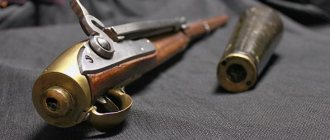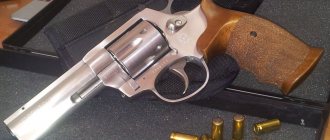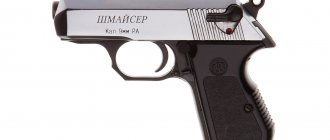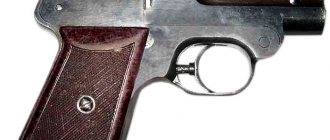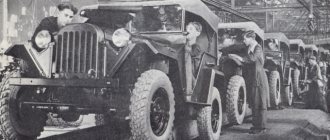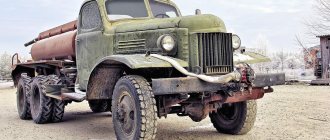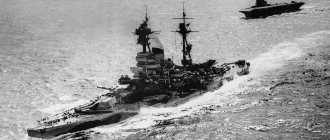The first revolver was created in 1818 by an officer from Massachusetts. The weapon got its name from the English. the words “revolve”, which translates as “rotate”. Since then, a considerable number of varieties of revolvers have been produced, the weapon becoming more and more advanced each time. Today it is believed that the era of this firearm has already passed; more modern and convenient models have come to the market. But it cannot be denied that the revolver was one of the unique inventions of mankind; this weapon can be called noble. Next, let's take a look at the list of the 10 best revolvers in the world.
The beginning of the history of the revolver
You may be interested in: Dormitory are sleeping quarters
People first heard about such a mechanism at the end of the 16th century, but then the drum was more often placed in a hunting rifle than in a pistol. This type of weapon did not take root at that time, since its production was expensive and complex.
The first was a flintlock revolver, which was patented by an American officer in 1818. Artemas Wheeler somehow gave a copy of his invention to Elisha Collier, who sailed to England and patented the weapon there in his name that same year. There, Collier opens a factory for the production of a revolver, but an improved version.
Breakthrough
You may be interested in: Sharp-witted is a characteristic of anyone who has shown an extraordinary mind
Revolvers of the 19th century appeared not only thanks to Wheeler and Collier. The invention of the capsule decided a lot, since many still wanted to achieve continuity of shooting. It was from that moment that mass production of such weapons began.
The first in this area was Samuel Colt, who already in 1836 opened a factory in the USA and developed his own revolver design. For about three decades, single-shot pistols were inferior to the new product. Since many things really came together thanks to Colt, some credit him with the invention of this weapon.
Diversity
Despite the fact that 19th century revolvers were roughly similar to each other, since they had a similar design, later they began to be differentiated by the type of frame and trigger mechanism.
You may be interested in: Construction of Moscow State University: years, history, interesting facts
In general, the revolvers consisted of:
- trunk;
- drum with chambers;
- body;
- Shitika;
- handles;
- framework.
But later pistols with a solid frame and a sliding frame began to appear. In the first case, the removal of used cartridges was carried out sequentially, and in the second - in one step using a breaking device or extending the drum.
The hammer's erection also varied depending on the firing mechanism. Revolvers were single-action, double-action or self-cocking.
Replica Adams revolver
Although Adams revolvers were manufactured in Belgium under license, the name "DAVID N. BREVETTE" on this revolver does not belong to the person who purchased the license. The weapon is similar to the D. Hermann revolver from Liege and is possibly a pirated copy. The frame is separated from the octagonal barrel, which is attached to it like a Colt barrel by means of a strong roll pin and boss. The extractor is attached to the left side of the barrel. The cylinder is of the usual type for Adams revolvers; it bears the mark of Liege. On the left side there is a spring safety...
Read more
Weapons in the 19th century
Of course, during its existence the weapon developed and improved. It began to be produced most actively in the 19th century. At that time, revolvers appeared almost every year, so there were a lot of models. But there were also the most memorable:
- Colt Paterson.
- Bundelrevolver Marietta.
- Colt Walker.
- Dreyse's revolver.
- Smith & Wesson Model 1,2 and 3.
- Lefaucheux M1858.
- Goltyakov revolver.
- Galand.
- Colt Single Action Army.
- Price's revolver.
- Colt Buntline.
- Nagant M1886.
- Webley.
- Type 26.
- Colt New Service.
Colt Paterson
This is Colt's first revolver in the 19th century. It was also the first percussion-type weapon, which Samuel Colt patented in 1836. This revolver got its name thanks to the city in which the manufactory was created. But later this pistol began to be called “Texas”, since it was in this republic that it gained great popularity.
At one time, Colt Paterson was used in the US Army, but not for long. It turned out that the weapon was unreliable and quite fragile. The Republic of Texas also purchased 180 copies. Although this particular model was not particularly popular, it provided early publicity for Colt's subsequent work.
Colt Walker
This is another Colt work and another 19th century capsule revolver. It has a 44 caliber, an overall length of 39 cm and a barrel length of 23 cm. Samuel Walker and Samuel Colt worked on the pistol. It was this weapon that became the favorite of the famous actor Clint Eastwood.
You may be interested in: Dinosaurs with spikes on their backs: name, description with photo
The revolver appeared in 1847. The basis for its creation was Colt Paterson. Officer Walker came to Colt and proposed creating a weapon that could be fired from a horse. Walker took the first 180 copies after production. Now this revolver continues its life, but slightly modified. Its replicas are still produced by some manufacturers in Europe and America.
Galan and Somerville
Charles Francois Galan, a partner in the Birmingham firm, made a joint bid in 1898 for a revolver with automatic ejection of spent cartridges, a version of which is shown here in the photograph. Weapons were produced both in Birmingham and on the Continent. In all likelihood, this revolver was not popular in Britain, but many good revolvers of this type were produced in Europe. The sample is made to a good standard, but has no name, although it has the inscription “W. POWELL OF BIRMINGHAM" may be the name of the seller. It has…
Read more
Revolver Dreyse
Johann Nikolaus von Dreyse, a famous gunsmith, once developed a needle weapon mechanism. His son Franz Dreyse refined his father's idea and introduced a needle revolver in 1850.
In the elongated breech of the handle there was a needle, which served as a striker. On the left side of the frame there was a recess where cartridges should be installed. The drum had space for six cartridges, in rare cases for five. The position of the front sight could be adjusted horizontally. The drum was attached to the axle.
Pressing the trigger activated the drum, then the spring was activated, which set the needle to the firing position. While the hook was returning to its position, the needle was released from the cocking action, passed the bottom of the paper cartridge, and then pierced the primer. This is how the shot took place.
Smith & Wesson Model
Smith and Wesson revolvers came in several modifications in the 19th century. The first was a seven-shot model, which was produced since 1857. It was the first commercially successful revolver. Its mechanism used a rimfire cartridge. Thus, it was possible to abandon gunpowder, bullets and primers as separate elements.
The Smith & Wesson (S&W) Model 2 has been in production since 1876. This sample had five charges. The weapon was a “breaker” type; the barrel lock moved upward, next to the trigger. This version also has an increased caliber.
The Smith & Wesson Model 3 began service in 1869. This model is often called Russian because it was exported to the Russian Imperial Army. After this, special drawings were created by Russian engineers, and according to them, countries began to manufacture these weapons themselves. Nowadays you can also find small productions of this model for collectors.
Vebley-Fosbury, model 1901
Designed by George Fosbury, a Victorian hero who was awarded the Victoria Cross (Britain's highest military decoration) at the age of 31, the Webley-Fosbury revolver is a remarkable weapon. It is essentially a hybrid of a semi-automatic pistol and a revolver. It opens, loads and unloads like any other Webley revolver. But when fired, the rollback of the upper part of the frame automatically cocks the hammer and turns the drum. The rotation of the drum occurs through the interaction of a pin protruding from the lower (fixed) part of the frame and shaped zigzag grooves on the outer surface of the drum. Naturally, the weapon is equipped with a manual safety, which is also unusual for a revolver.
The Webley-Fosbury Model 1902 in .455 caliber was a modified version of the Model 1901 semi-automatic revolver that used recoil to rotate the cylinder
Before World War I, this revolver was popular with British officers who could afford custom-made weapons. The Webley was chambered in .455 caliber and chambered for the standard British cartridge; Later, revolvers chambered for the .38 AKP cartridge were also produced. With a supply of six-round clips on hand, an experienced shooter could fire up to 70 rounds per minute.
When the United States entered World War I, the M1911 chambered in .45 AKP was unable to keep up with the influx of orders from the US Army. Two revolvers were selected to fill the shortage: New Service and New Century. The British used both revolvers on the Western Front. Taking into account the accumulated combat experience, the design of the Smith and Besson weapon was modified. The New Service, chambered for the .45 AKP cartridge, was designated the Colt Model 1917. It could be quickly reloaded from either two semi-circular clips of three rounds each, or from one round clip of six rounds.
The caption for this American poster reads: “A cowboy spurs his horse and escapes from the Indians with a Smith & Wesson revolver.” The poster was released at the end of the 19th century. and advertises Smith and Wesson revolvers
"Three Eights"
After World War I, the British War Office decided that tank crews and support personnel needed a more compact revolver.
The result was the Enfield No. 2 Mk I .38 caliber, developed by the Enfield State Arms Factory in 1926-1927. It was a smaller copy of the Webley Mk VI revolver and retained the unlocking frame and six-round cylinder. The trigger mechanism was slightly modified, with a manual trigger safety and a separate cylinder lock. In 1932, this revolver was adopted for service under the designation “Enfield No. 2” Mk I in .38 caliber. After 1938, almost all revolvers No. 2 Mk I were converted into model No. 2 Mk I *.
“Enfield No. 2” Mk I* was developed in the late 1930s for tank troops and differed from the earlier Mk I revolver in the trigger mechanism, allowing only self-cocking fire, the absence of a spoke on the trigger, a weaker mainspring and cheeks on the handle. The trigger without a spoke, which was a requirement of the command of the armored forces, made it possible to carry a weapon in an open holster without fear of getting caught on anything in the cramped fighting compartment of the tank.
Revolver "Enfield No. 2" Mk I of the first issue. In the late 1930s it was modified to suit the British Army and remained in service until the late 1960s.
Simplified in accordance with wartime requirements, the Enfield No. 2 Mk I** appeared in 1942. It is similar to the model No. 2 Mk I*, but does not have a trigger safety. After 1945, all Enfield revolvers were withdrawn and converted to the No. 2 Mk I* configuration. This revolver, nicknamed the “Three Eights” by the British Army, was a powerful and reliable weapon.
Share link
Lefaucheux M1858
This weapon became known in France thanks to Casimir Lefauchet. The first version of the designer worked with a hairpin chuck. After this, in 1853, the revolver was adopted into service in the country. This event marked the beginning of the use of this type of weapon in the army.
The 1858 version is equipped with an octagonal barrel with a front sight. The drum received protrusions. When the cartridge comes in line with the barrel, the cylinder is locked. The hammer can be cocked manually. The spring protects the rod from accidentally falling into the drum.
By the way, Lefoshe revolvers were also used by the army of the Russian Empire. The Officer Shooting School liked them and were considered comfortable and simple.
Rast-Gasser, model 1898
In the middle of the 19th century, Leopold Gasser put the production of revolvers on a grand scale. Its factories were located in Austria, and revolvers were widely used by the military of the Balkan states. Shown here is a Rast-Gasser Army revolver, Model 1898. It has a one-piece frame with a round barrel screwed to it. The drum, which holds eight rounds, is quite simple, except for the slotted holes to secure it. The revolver is loaded through the charging door, which has a small protrusion that ensures the alignment of the cylinder and frame. ...
Read more
Goltyakov revolver
There were very few Russian revolvers of the 19th century. Often, foreign inventions or ready-made drawings were used in Russia. But in 1866 the Goltyakov revolver was released. This is a five-round capsule model. Produced at the Tula factory.
The pistol had a 44 caliber, a solid closed steel frame, but was produced without a charging lever. The trigger mechanism was self-cocking, and the trigger did not have a spoke. The factory at one time produced 71 copies and demanded 15 rubles per piece.
"Bulldog" (copy)
In 1878, the English company, which by that time already enjoyed an excellent reputation, released a series of revolvers under the general name “British Bulldog”. They had a one-piece frame, as well as a drum for five cartridges of 11.2 mm or 11.4 mm caliber. The weapon was intended for personal defense. At that time, Britain was calm, there were few criminals, but people bought weapons in case of burglaries. It was also in demand among citizens working in remote corners of the British Empire. Soon reliable Bulldog revolvers...
Read more
1 more >
Galand
Another Belgian revolver, which was released in 1868 under a patent. Interestingly, they worked on it for the Russian Navy. The drum could hold up to six 12mm cartridges.
The peculiarity of the revolver was its unusual and capricious design. During reloading, part of the frame, drum and barrel were partially pushed forward. Weapons were manufactured for special cartridges, which replaced pin-type ammunition. There were military samples with a caliber of 12 mm, and there were commercial ones - 7 and 9 mm.
Galan worked a lot on revolvers. Therefore, over the course of four years, several types of weapons were released. The first was a pistol of the 1868-1872 model, followed by a pocket model with reduced dimensions. There was also a “Baby” revolver, which turned out to be even smaller than the previous one.
Colt Single Action Army
This particular model of a revolver from the late 19th century was developed specifically at the request of the US government, and after a series of tests it was adopted by the army. The weapon is a six-shot, single-action weapon.
The revolver turned out to be popular due to the fact that it was simple, but at the same time powerful and heavy. This weapon turned out to be prefabricated, since it was made according to several Colt drawings. This is probably why the design and construction of the handle, partly the appearance of the trigger and the trigger mechanism have been preserved. To all this was added a monolithic closed frame and the use of special cartridges.
You may be interested in: Creation of a nuclear missile shield in the USSR
4. SwissMiniGun
This model of firearm is the smallest and was invented in Switzerland. The appearance of the revolver is similar to the Colt Python model. The SwissMiniGun itself is 55 mm long and has a caliber of 2.34 mm. The “little killer” weighs just over 100 g. Firearms collectors do not consider this model of revolver to be a real means of self-defense, but are happy to purchase it as another copy. The cost of this type of weapon in the simplest production (without additional decorations) is about 6500-6700 Swiss francs.
Nagant M1886
Another revolver from the late 19th century, which was created for the Russian Empire. The weapon had seven charges, and was developed by the brothers Emil and Leon Nagant. The 1886 model received reduced weight, a reliable and technological design. For example, it was decided to replace four springs with one double spring. It was decided to go in the direction of reducing the caliber, so the revolver received 7.5 mm.
This 19th century revolver gained particular popularity in Russia. It began to be used actively in 1900. By 1914, almost 500 thousand copies were put into service. It is also believed that the Nagan became one of the symbols of the Russian Revolution. Because of the events of 1917, other models and even self-loading pistols were often named after this revolver.
Webley
This is a British weapon that was used for a long time by the countries of the British Commonwealth. It is believed that the revolver was in service from 1887 to 1963. It was designed for rapid reloading and firing, so a breaking frame design was used.
During the First World War, this weapon turned out to be the most popular. A cartridge of the same name was specially developed for it. From that moment on, this revolver became the most powerful weapon of this design. Now, despite the fact that the cartridge has ceased to be produced, it is still used in service in a number of countries around the world.
After the cartridge of the same name was stopped being produced, it was decided to rework the weapon for .45 ACP.
Type 26
This weapon is also known as the Hino revolver. It was developed in Japan in 1893 and was also adopted by the Imperial Japanese Army. This model got its name due to the special chronology that is still used in its homeland.
Initially, it was decided to adopt this revolver for cavalry use. In this case, a safety cord was used, attached to a ring on the handle. It is a breakaway style pistol and was somewhat similar to the early Smith & Wesson models. The trigger worked without a spoke. The weapon used 9×22 mm R cartridges.
Gasser revolver
A large Austrian company was founded in 1862 by Leopold Gasser, who patented this revolver in 1870. After the death of L. Gasser in 1871, his son Johann succeeded him, who continued the mass production of this and similar revolvers until the end of the 19th century. Gasser revolvers were in service with the Austro-Hungarian army and sold well in Austria-Hungary and the Balkan Peninsula. This weapon, like other Gasser revolvers, has a split frame. Its design is very reminiscent of the early Colt, except...
Read more
Colt New Service
This is one of the last 19th century revolvers in America. Then Colt was already working on it. It was produced from 1898 to 1940. Its peculiarity was that it could use various cartridges. The revolver was adopted by the US Army and Navy.
Its design was not new: a solid solid frame, a drum that folds to the left. The double-action trigger mechanism was well thought out, so even with pre-cocking the hammer it was possible to shoot accurately.
Source
Revolvers - past, present, future
Home | Weapons | Additional Articles | Revolvers - past, present, future
In the 20th century, revolvers, as a type of personal firearm, reached their greatest prosperity and popularity in the 50-70s in the United States of America. Revolvers have always been in great demand in this country, dating back to the days of the “Wild West” and capsule Colts. The rapid development and widespread distribution of this type of weapon in the United States began with the early capsule Colt 1851 Navy and Colt 1860 Army, as well as Smith & Wesson No. 1 chambered for a unitary cartridge. Later came the famous Colt 1873 Peacemaker .45 caliber and Smith & Wesson No. 3 .44 caliber. The use of unitary cartridges provided a great advantage in loading speed and ease of storing ammunition compared to capsule systems.
Beginning with the Adams Model 1851 in England and the Starr 1858 Army in the United States, revolvers began to be made with a double-action trigger mechanism, which allowed the weapon to be fired by self-cocking by simply pulling the trigger without first cocking the hammer. The combination of using a unitary cartridge and a trigger mechanism with self-cocking made the revolver a convenient, practical weapon with very high combat qualities for its time. Instead of sequential extraction of spent cartridges, like the Colt 1873, drums that tilt to the side began to be used, which again significantly increased the rate of fire.
Compared to systems loaded with a release case, used in Smith & Wesson No. 3 revolvers and English Webleys, the design with a folding cylinder and a monolithic frame provided both a longer service life and higher accuracy of shooting of revolvers with a large round of shots. These innovations greatly improved the combat qualities of revolvers and continue to be used today with minimal changes. By the beginning of the 20th century, the following models became the most famous and popular models: Colt New Service 45th, 44th and 38th calibers, which was later adopted by the US Army under the name Model 1909; Smith & Wesson New Century revolver in 45 and 44 calibers, with reinforced Triple Lock cylinder locking design; Smith & Wesson Military & Police 1905 38-caliber revolver, which became the most popular military revolver in the United States in the first half of the 20th century.
Military & Police became especially popular because it had small dimensions and weight, low recoil force and a very reasonable cost. In total, over 6 million M&P revolvers were produced. During World War I and World War II, the US and British armies used the Colt Model 1917 and Smith & Wesson Model 1917 revolvers, which fired .45 ACP pistol cartridges with a wafer case. It was these revolvers from the beginning of the century that became the basis for the design of those revolvers that are currently offered by weapons manufacturers. Changes in modern models compared to their predecessors relate mainly to the materials used and production technology.
Colt 1909 revolver chambered for .45 Long Colt
Smith & Wesson Military & Police 1905 .38 gauge with blue finish and walnut grips
Since the end of World War II, modern-style revolvers have been in service with the US police and army. It should be noted that revolvers have always been popular in America, and did not lose their positions in the civilian and police arms markets even after the advent of well-proven self-loading pistols, such as the Colt M1911 or FN Browning High Power. Powerful full-size revolvers were very popular among road patrols, where police officers are still armed with them. These were classic revolvers produced by the largest weapons manufacturers - the famous American companies Smith & Wesson, Colt and Ruger. Full-size models used the powerful .357 Magnum cartridge, which has a high stopping and penetrating effect of the bullet.
Compact ones, used as a rule by FBI agents or plainclothes police officers, as well as by citizens for self-defense, used the .38 Special cartridge, which was significantly inferior in its combat qualities. It’s paradoxical, but true - despite the availability of revolvers chambered for 9 mm .357 Magnum, 11.5 mm .45 LC and .45 ACP cartridges that have proven highly effective in real combat and in police practice, revolvers chambered for weak 9-mm cartridges have been sold in the millions .38 Special. The Smith & Wesson Military & Police was especially in great demand, becoming perhaps the most popular revolver in its class. Its advantages, as well as other 38-caliber revolvers, were the low cost of weapons and ammunition, as well as soft recoil without strong bounce when fired, which are the main reasons for its success.
Colt Detective Special .38 caliber, 1950 release. The drum holds 6 rounds.
Smith & Wesson Model 36 Chief's Special sub-cartridge .38 Special with 5-round cylinder capacity
The most famous compact revolvers of the 20th century, which achieved enormous popularity in the USA, were the Smith-Wesson models S&W Model 36 Chief's Special (in production since 1950), S&W Model 40 (produced since 1952), S&W Model 49 Bodyguard (produced with 1957) and S&W Model 60 (produced from 1965), as well as the Colt Detective Special (produced from 1927 to 1995). American manufacturers had a large line of full-size .357 Magnum revolvers with a variety of frame sizes, barrel lengths, materials and finishes that were consistently purchased by various law enforcement agencies and, of course, sold well on the civilian gun market.
The most popular of the full-size models were the S&W Model 27 (produced from 1935 to 1994), S&W Model 19 (in production since 1957), S&W Model 66 (produced from 1970 to 2005), S&W Model 686 with a stainless steel frame (introduced in 1980 and still in production) and the S&W Model 586 with an alloy steel frame and blued finish (in production from 1982 to 1998). The Colt company began producing the famous Colt Python revolver in 1955. Less known, but still popular, were the Colt Trooper MKIII, Colt MKV (in production from 1953 to 1985), and the Colt King Kobra (in production from 1986 to 1998). The period from the end of World War II to the second half of the 1980s. is the "golden age" of American revolvers.
Just look at the famous Colt Python, which uses .357 Magnum cartridges, which became a star among weapons in Hollywood and Elvis Presley’s favorite revolver. This weapon is distinguished not only by its exquisite design, but also by its excellent workmanship and surface finish, excellent shooting accuracy and reliability. Python is still produced by Colt. The most charismatic of the large-caliber revolvers was the Smith & Wesson Model 29 revolver, introduced by the manufacturer in 1955 and discontinued by the end of the 1990s, using the most powerful .44 Magnum cartridge at that time. This weapon in the United States is most associated with the police officer nicknamed “Dirty Harry” from the famous 1971 film starring Clint Eastwood, in addition to the Model 29, of course. It is especially worth highlighting the highest quality of workmanship of revolvers produced before the mid-1980s, which today can only be obtained in more expensive weapons.
The quality workmanship on this blued Colt Python is evident at first glance.
The S&W Model 29 was the epitome of power thanks to the .44 Magnum cartridge and... Hollywood
The high popularity and wide distribution of revolvers is explained not only by their ease of use, reliability, high shooting accuracy, efficiency when using, for example, .357 Magnum cartridges or even less powerful .38 Special cartridges, equipped with expansive bullets with high stopping power, but also, of course, by established habits. It is noteworthy that the excellent Georg Luger pistol, which later became known as the Parabellum, with advanced combat and performance qualities for its time, which still remains the standard for ease of holding, shooting accuracy and weapon aesthetics, was not adopted by the US Army mainly because for the established stereotypes of the American military, who preferred revolvers rather than new weapons that were not yet familiar to them.
Of course, at first, a good reason for the Americans to abandon the Luger pistol was the weak 7.65×22 cartridge compared to the .45 Long Colt revolver, but soon the designer introduced a model chambered for the 9×19 cartridge, and then a version chambered for the new American pistol cartridge. 45 ACP. However, in this case, prejudices prevailed. Although it should be noted here that the Luger pistol was much more expensive than any American revolver, the production of which had long been established and the army had vast experience in handling these weapons. In Europe, on the contrary, self-loading pistols have become widespread. These were mainly John Browning designs, produced by the Belgian FN and copied in huge quantities by Spanish manufacturers, Georg Luger pistols, manufactured by the German DWM, and the equally famous Mauser pistol-carbines.
Colt M1911A1 semi-automatic pistol
Colt Government manufactured in 1928
But soon even the American military realized the advantages of automatic weapons, adopting, which later became one of the most popular self-loaders, a pistol designed by Browning - the famous Colt M1911 45 caliber. Moreover, at the beginning of its career this pistol was not as popular among ordinary citizens as it was in the 70-90s. and currently. The M1911 fully demonstrated its advantages in high fire efficiency on the battlefields of the First World War. For example, the feat of US Army Corporal Alvin York, who killed six German soldiers armed with Mauser rifles attacking him with his M1911, is widely known. Its modernized version, designated M1911A1, also performed well during World War II.
However, from the moment the self-loading Colt was adopted into service until the second half of the 20th century, in the civilian arms market it was popular mainly among those who had served in the army and navy, while revolvers were popular among ordinary citizens and police officers. The version of the M1911 for the civilian weapons market, called the Colt Government Model, which differed from army weapons only in the higher quality of the coating and stamps, was not liked by everyone because of its size and weight. It is difficult to carry such a massive pistol with you constantly and secretly. Compact revolvers, on the contrary, are very convenient, lightweight and much easier to handle than the Government Model. It was only in the 1950s, thanks to articles about the advantages of the M1911 by one of the most famous pistol pilots, journalist and founder of modern practical shooting, Jeff Cooper, that the M1911A1 gradually began to be purchased by some police departments and gain popularity among citizens.
Smith & Wesson Model 19
Ruger GP100
Thus, from the first quarter of the 20th century until the 80s, two branches of personal short-barreled weapons dominated in the United States - compact and full-size revolvers, as well as self-loading pistols from Colt. The fighting qualities of full-size revolvers, especially the efficiency of firing .357 Magnum cartridges, suited everyone, but time does not stand still and self-loading 9 mm pistols with a large magazine capacity soon began to arrive in large quantities on the largest weapons market in the world. They quickly began to gain popularity in the country of revolvers and soon began to displace the weapons familiar to Americans.
In addition, these pistols were equipped with a double-action trigger mechanism, which made it possible to safely carry a loaded weapon that was in full combat readiness, without the need to turn off the safety lever. But nevertheless, in terms of ease of use and reliability of operation, such pistols were inferior to revolvers, since in the event of a misfire, the revolver can always fire the next shot simply by pressing the trigger, while the owner of a self-loading pistol can reliably eliminate the delay in firing it is necessary to remove the misfired cartridge by sending the next one from the magazine into the chamber of the barrel. Examples of 9 mm pistols with a large magazine capacity, double-action trigger mechanism and reliable safety systems are the American Smith & Wesson Model 59 (in production from 1970 to 1988), the German Sig Sauer P226 (manufactured since 1981) and the Italian Beretta series 92 pistols (manufactured since 1976).
The S&W Model 59 9mm pistol with a 14-round magazine is considered the first of the "wonder nines"
The Glock 17 remains one of the most popular and best-selling semi-automatic pistols in the world.
Such pistols became known in the USA as “wonder nines”, that is, “amazing nines”. A significant fact is the rearmament of the US Army in 1985 from the usual Colt M1911A1 to the Beretta M9 - the popular Italian Beretta M 92FS pistol produced in America. However, in the early 1980s. revolvers were still the favorite weapon of ordinary citizens and police officers. The stopping power of the 9mm Parabellum cartridge bullets, including hollow-point ones, was not comparable to that of the .357 Magnum revolver bullets. Out of habit, revolvers were still trusted more than, for example, the same self-loading Smith-Wesson pistols. Among small-sized personal weapons for concealed carry, compact revolvers chambered for the .38 Special cartridge also remained unrivaled.
Since 1980, following the 9-mm repeating pistols, the basic design of which dates back to the first quarter of the 20th century, the most serious competitor for all previously produced short-barreled weapons went into production - the Austrian self-loading pistol Glock 17, which has only automatic safeties and a trigger a striker-type mechanism, with preliminary, partial cocking of the firing pin when the bolt-casing moves back and additional cocking when the trigger is pressed. This meant that this weapon could be instantly fired and carried constantly without the risk of an accidental shot, with maximum simplicity and ease of use. The design of the Glock is extremely simple and is based on the proven and improved Browning locking system; the metal parts have a very durable Tenifer coating that is extremely resistant to corrosion and wear.
Thanks to all these qualities, the weapon has phenomenal reliability in difficult operating conditions and a huge service life. In addition, the Glock frame is made of polymer, due to which it is very light in comparison with revolvers and self-loading pistols made of steel or with light alloy frames. In terms of firepower, the Glock 17 pistol is not at all comparable to revolvers, since its double-row magazine holds 17 rounds, versus a maximum of 7 or 8 for revolver drums. The Colt M1911 pistol, equipped with a single-action trigger mechanism with the ability to be safely carried in full combat readiness only with the hammer cocked and the safety on, as well as its copies, could no longer dominate in the United States among self-loading pistols.
Having taken leading positions in the weapons market, multi-shot modern 9-mm pistols began to displace revolvers, which were unable to compete with them in terms of the combination of combat and operational qualities. Despite habits and stereotypes, under the influence of new technologies and the advantages of self-loading pistols, revolvers are practically a thing of the past. In most police departments they were replaced with pistols, and citizens began to purchase Glocks, Sig-Sauers, Berettas, ChZs, Heckler-Kochs, Rugers, Smith-Wessons, Walters and other “self-loaders” for self-defense and sporting and recreational shooting. From the mid-1980s to the present, the main type of short-barreled personal weapon has been a self-loading pistol. However, the revolver did not lose its undeniable advantages, thanks to which these weapons continue to be used willingly.
Eight-shot Taurus 627 Tracker
Full size Smith & Wesson Model 327 M&P R8 revolver chambered in .357 Magnum with an aluminum-scandium frame and 8-round cylinder capacity
In the late 1990s, new materials began to be used in the production of revolvers, such as alloys based on aluminum and titanium, lightweight and durable aluminum-scandium alloys. Drums are made either of stainless steel with an additional anti-corrosion, usually matte black coating, or of titanium. As a result, revolvers got rid of one of their main drawbacks - heavy weight, while maintaining the necessary safety margin, a fairly long service life and excellent corrosion protection. Now it has become convenient and easy to carry not only compact, but also medium-sized revolvers with you at all times. Full-size models are still very rarely used for wearing due to their size.
Smith-Wesson and the Brazilian Torus were especially successful in using new technologies and materials. Their lineup includes a variety of lightweight and durable modern revolvers chambered for a variety of cartridges. Although the recoil force when firing from such a revolver, if it uses the powerful .357 Magnum cartridge, has increased significantly, the new weapon has become very popular and has a stable demand, both in the civilian market and among police officers. In addition, for training, revolvers under .357 Magnum most often use the much less powerful .38 Special, when fired with much less recoil force. The drum capacity has also increased. Many modern revolvers have a seven- and eight-round drum, which is more than enough for self-defense. Of course, self-loading pistols are in service today in the US army and police, as well as in other countries of the world. In United States police, revolvers are a rare exception and are only used in low crime areas where the officer does not need high firepower or by highway patrols. Revolvers are most popular among ordinary citizens.
The American Smith & Wesson Model 686 revolver is a true classic among modern full-size six-shooters.
The Smith & Wesson Model 625 JM revolver uses .45 ACP cartridges
Full-size models chambered for the .357 Magnum cartridge, with a barrel length of 102 mm / 4 inches and drums with a capacity of 6, 7 or 8 rounds, are rarely used as the main short-barreled weapons, since, surpassing modern pistols in reliability, bullet stopping power of the cartridge used, accuracy firing in single-action mode and ease of handling, they are significantly inferior to repeating pistols in rate of fire, firepower (the drum capacity is more than half that of a double-stack magazine of a medium-sized pistol) and have significantly larger dimensions, especially in width.
Such weapons are stored at home or in a car for self-defense. They are often used in various types of sports shooting and even for hunting, as well as for the purpose of self-defense from predators during hiking trips. Mid-sizes such as the Smith & Wesson 625, with a 102mm/4" or 127mm/5" barrel, chambered in .45 ACP, are most popular among sport revolver shooters due to the fast reloading of the plate clips and low recoil. and tossing when firing, and as a result, a higher rate of fire and accuracy of high-speed fire. In addition to these advantages, this weapon is highly effective in combat shooting, thanks to the high stopping power of the .45 ACP cartridge bullet. Therefore, such weapons are universal in areas of application and can also be purchased for self-defense.
Smith & Wesson Model M&P 360
Featuring an ultra-light Scandium frame, the Smith & Wesson Model M&P 340 is very comfortable and lightweight to carry. This specimen is equipped with rubber grip cheeks with a built-in laser designator.
Compact five-shot, with 51 mm / 2 inch barrels, chambered for the .357 Magnum cartridge, ideal for concealed carry for self-defense or as a backup weapon due to the combination of small dimensions and weight with the high stopping power of the bullet of the cartridge used. This class of revolvers is the most popular at present and will most likely be the most popular in the future. In addition to the qualities of the revolvers themselves, the arms market currently offers many very useful accessories, such as fiber optic front sights and rubber grip cheeks with a built-in laser designator. Practice has shown the advantages of front sights with fiber-optic, light-collecting inserts in the form of green or red rods, which reduce the time of pointing the weapon at the target, since the axis of the rod is a guide for the flow of light, as a result of which the shooter’s attention is instantly concentrated on the front sight, and then it is very easily quickly aligns with the rear sight slot.
One of the best representatives of modern compact revolvers is the American Smith & Wesson M&P 340 with an aluminum-scandium frame, a hidden hammer and only a self-cocking trigger mechanism, which has a very smooth ride and low trigger pull, light weight and compactness. This five-shot revolver chambered for the powerful .357 Magnum cartridge is very convenient for constant concealed carry, not burdensome and easy to handle for its owner. Of course, such a lightweight revolver, weighing only 414 g, has strong recoil, but it is not intended for sport shooting, since it is primarily a self-defense weapon. According to the enormous volume of information on the use of personal short-barreled weapons and statistics maintained by the US police, shooting to kill using compact concealed weapons is carried out at ultra-short distances - from point-blank shooting to 4-6 meters. In this case, the first shots are decisive, and the capacity of the revolver drum, designed for 5 rounds, is quite sufficient for such use of weapons.
It is necessary to clarify that for police weapons carried openly as the main one, on the contrary, a large amount of ammunition is required, as evidenced by the practice of using service weapons by the police. For close combat, in any case, the stopping effect of a bullet is of great importance, since it is necessary to neutralize the enemy as quickly as possible. The .357 Magnum revolver cartridge copes well with this task, as evidenced by decades of its practical use by police officers and citizens in self-defense. The reliability of a weapon is also of great importance, and a revolver has always been orders of magnitude superior, and will continue to be superior in this quality to any self-loading pistol. All of the above-mentioned features of revolvers and the ammunition used in them, combined with new technologies and materials, paved the way for this type of personal weapon in the 19th century and ensured its, although not very high, but nevertheless very stable popularity, which is confirmed by the constant appearance of new models on the arms market.
Additional articles
- Self-cocking pistols
- Merwin-Hulbert revolvers
- Weapons retroconservatism
- Shooting canes and umbrellas with a blade
- Revolvers - past, present, future
- Revolvers Velodog
- Walther Model 9 pocket pistol
- Colt Detective Special - Noir Style Revolver
- Gletcher CLT 1911. Affordable Colt
- Gasser M1870/74 Montenegrin
- British gun "Brown Bess" - an imperial classic
- Modular grenade launcher XM-25
- RPK 74M
- RPK 16
- RPL-20 and KORD-5.45.
